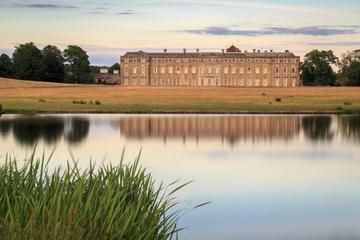Heritage as Business
‘We are in the business of conservation access.’ So did Hilary McGrady, Director of Operations and Consultancy at the National Trust, introduce the conversation evening on Thursday 4 May, hosted by The Oxford Research Centre in the Humanities (TORCH) and their Trusted Source Knowledge Transfer Partnership. This was the fourth event in the MOVING, TEACHING, INSPIRING lecture series currently running at the University of Oxford in collaboration with the Trust.
It might seem obvious, but like all third sector organisations, a ‘business-like’ approach is crucial to enable the National Trust to do what it does best. As Pegram Harrison, Senior Fellow in Entrepreneurship at Oxford Saïd Business School, later sketched out, heritage organisations such as the National Trust need to be able to manage their resources – the land, buildings and other heritage they safeguard - as much as any other business. The Trust has its own unique business challenges – lack of wifi and 3G signal in remote locations, for example, or the unique challenges (and opportunities) of a largely voluntary workforce – and like any business must find the most practical and efficient way around these. And like any other business, the Trust has learnt important lessons about the power of brand, of understanding, engaging and keeping an audience, and of managing a very large and diverse workforce.
And the National Trust really is big business. It employs 11,000 people and occupies 60,000 volunteers nationwide, to cite just one of the extraordinary figures that were offered up by both speakers. It is the biggest hitter in the UK’s fourth or fifth largest industry – the industry of heritage. As Pegram showed in the lead-in to his part of the evening, heritage drives tourism in the UK: a third of overseas and two thirds of domestic tourists in the UK are visiting heritage sites. Heritage contributed £20 billion to our GDP and 386,000 jobs, and there were 24 million visitors in the last year to historic houses alone (which is strikingly fewer than visited the whole of Japan in the same year). Beyond simple tourism, heritage also has knock-on effects in other sectors: heritage sites can, for example, increase the value of nearby property by as much as 30%.
The ‘business of heritage’ is, however, not without its critics. It has, in truth, too often been seen as a challenge to the core purposes of conservation charities such as the National Trust. (You only need to ask the characters in Alan Bennet’s People to see the low esteem in which a business-like approach to heritage is held by so many). But it is ‘not just about making money’. In fact, money-making must be subservient to the Trust’s own values and its own core purpose. As Hilary pointed out, of the money that comes into the Trust (of its £522 million income, £155 million comes from its operational ‘business’, with the rest coming from sources such as membership, fundraising and grants), anything that is not spent on operating costs goes straight back into conservation and visitor experience projects. It is, after all, the organisation’s core mission – ‘for ever, for everyone’ – that drives the whole enterprise. The main cost of running the Trust is balancing the competing demands of ‘for ever’ and ‘for everyone’.
So ‘What,’ as a member of the audience asked, ‘can business schools do to help?’ Pegram pointed out that business schools are now alert to the fact that the business of business is about more than business – that the skills, techniques and processes of the private sector are applicable to the public sector and, moreover, that the private sector can learn a lot about values, about humans as well as processes, about engaging with others from the public sector.
It is these lessons – the lessons of value and purpose for which ‘business’ is a means to an end – which the National Trust is so well-placed to teach. Hilary started her lecture talking about a National Trust property in her native Northern Ireland – the Black Mountain, just outside Belfast. This had once been a military base and a no-go area during the troubles, but thanks to the Trust, it is now being looked after and made accessible to the local populace. This, she is clear, is the point of everything she does. The National Trust is uniquely placed to both maintain and open up these special and previously out-of-bounds places. The ‘business of heritage’ simply allows them to do this better.
This event and all others in the MOVING, TEACHING, INSPIRING series can be watched again here.
- Catherine Farfan, Research Communications & Impact Support Officer, Said Business School



